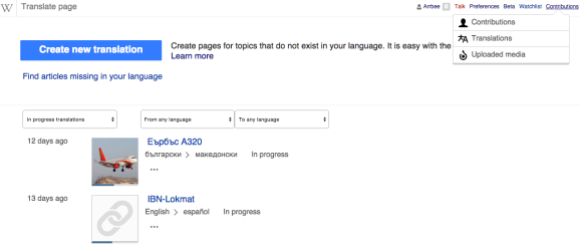
The Content Translation tool makes it easier to create new Wikipedia articles from other languages. You can now start translations from your Contributions link, where you can find articles missing in your language. Screenshot by Runa Bhattacharjee, licensed under CC0 1.0
Since it was first introduced three months ago, the Content Translation tool has been used to write more than 850 new articles on 22 Wikipedias. This tool was developed by Wikimedia Foundation’s Language Engineering team to help multilingual users quickly create new Wikipedia articles by translating them from other languages. It includes an editing interface and translation tools that make it easy to adapt wiki-specific syntax, links, references, and categories. For a few languages, machine translation support via Apertium is also available.
Content Translation (aka CX) was first announced on January 20, 2015, as a beta feature on 8 Wikipedias: Catalan, Danish, Esperanto, Indonesian, Malay, Norwegian (Bokmal), Portuguese, and Spanish. Since then, Content Translation has been added gradually to more Wikipedias – mostly at the request of their communities. As a result, the tool is now available as a beta feature on 22 Wikipedias. Logged-in users can enable the tool as a preference on those sites, where they can translate articles from any of the available source languages (including English) into these 22 languages.
Here is what we have learned by observing how Content Translation was used by over 260 editors in the last three months.
Translators
To date, nearly 1,000 users have manually enabled the Content Translation tool — and more than 260 have used it to translate a new article. Most translators are from the Catalan and Spanish Wikipedias, where the tool was first released as a beta feature.
Articles
Articles created with the Content Translation tool cover a wide range of topics, such as fashion designers, Field Medal scholars, lunar seas and Asturian beaches. Translations can be in two states: published or in-progress. Published articles appear on Wikipedia like any other new article and are improved collaboratively; these articles also include a tag that indicates that they were created using Content Translation. In-progress translations are unpublished and appear on the individual dashboard of the translator who is working on it. Translations are saved automatically and users can continue working on them anytime. In cases where multiple users attempt to translate or publish the same article in the same language, they receive a warning. To avoid any accidental overwrites, the other translators can publish their translations under their user page — and make separate improvements on the main article. More than 875 new articles have been created since Content Translation has been made available — 500 of which were created on the Catalan Wikipedia alone.
Challenges
When we first planned to release Content Translation, we decided to monitor how well the tool was being adopted — and whether it was indeed useful to complement the workflow used by editors to create a new article. The development team also agreed to respond quickly all queries or bugs. Complex bugs and other feature fixes were planned into the development cycles. But finding the right solution for the publishing target proved to be major challenge, from user experience to analytics. Originally, we did not support publishing into the main namespace of any Wikipedia: users had to publish their translations under their user pages first and then move them to the main namespace. However, this caused delays, confusion and sometimes conflicts when the articles were eventually moved for publication. In some cases, we also noticed that articles had not been counted correctly after publication. To avoid these issues, that original configuration was changed for all supported sites. A new translation is now published like any other new article and in case an article already exists or gets created while the translation was being done, the user is displayed warnings.
New features
Considering the largely favorable response from our first users, we have now started to release the tool to more Wikipedias. New requests are promptly handled and scheduled, after language-specific checks to make sure that proposed changes will work for all sites. However, usage patterns have varied across the 22 Wikipedias. While some of the causes are outside of our control (like the total number of active editors), we plan to make several enhancements to make Content Translation easily discoverable by more users, at different points of the editing and reading workflows. For instance, when users are about to create a new article from scratch, a message gives them the option to start with a translation instead. Users can also see suggestions in the interlanguage link section for languages that they can translate an article into. And last but not least, the Contributions section now provides a link to start a new translation and find articles missing in your language (see image at the top of this post).
In coming months, we will continue to introduce new features and make Content Translation more reliable for our users. See the complete list of Wikipedias where Content Translation is currently available as a beta feature. We hope you will try it out as well, to create more content
Runa Bhattacharjee, Language Engineering, Wikimedia Foundation

Can you help us translate this article?
In order for this article to reach as many people as possible we would like your help. Can you translate this article to get the message out?
Start translation

